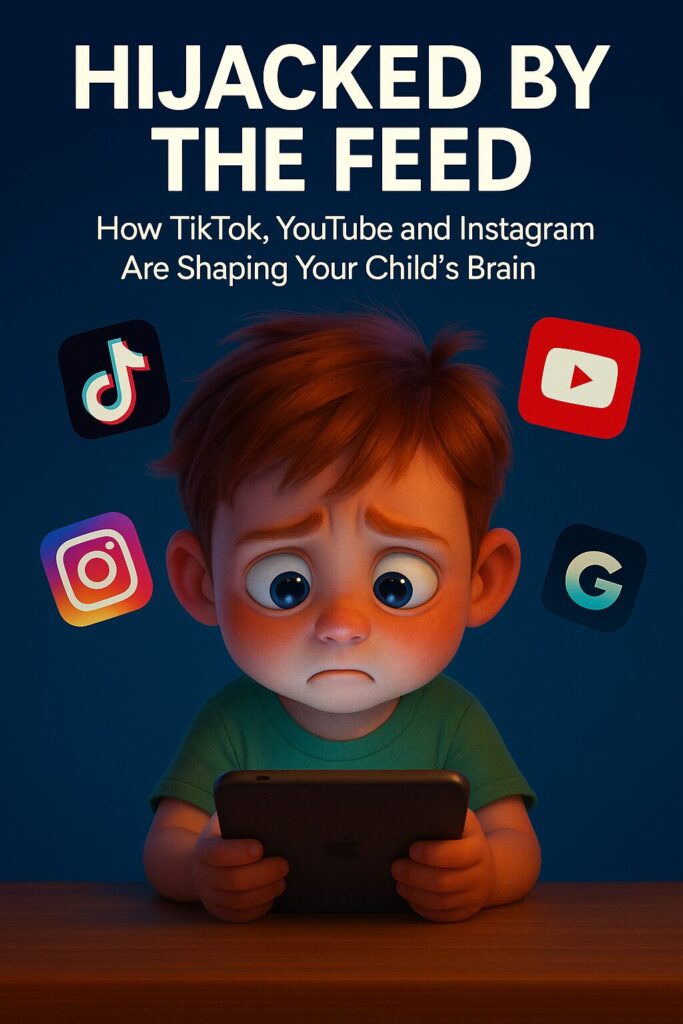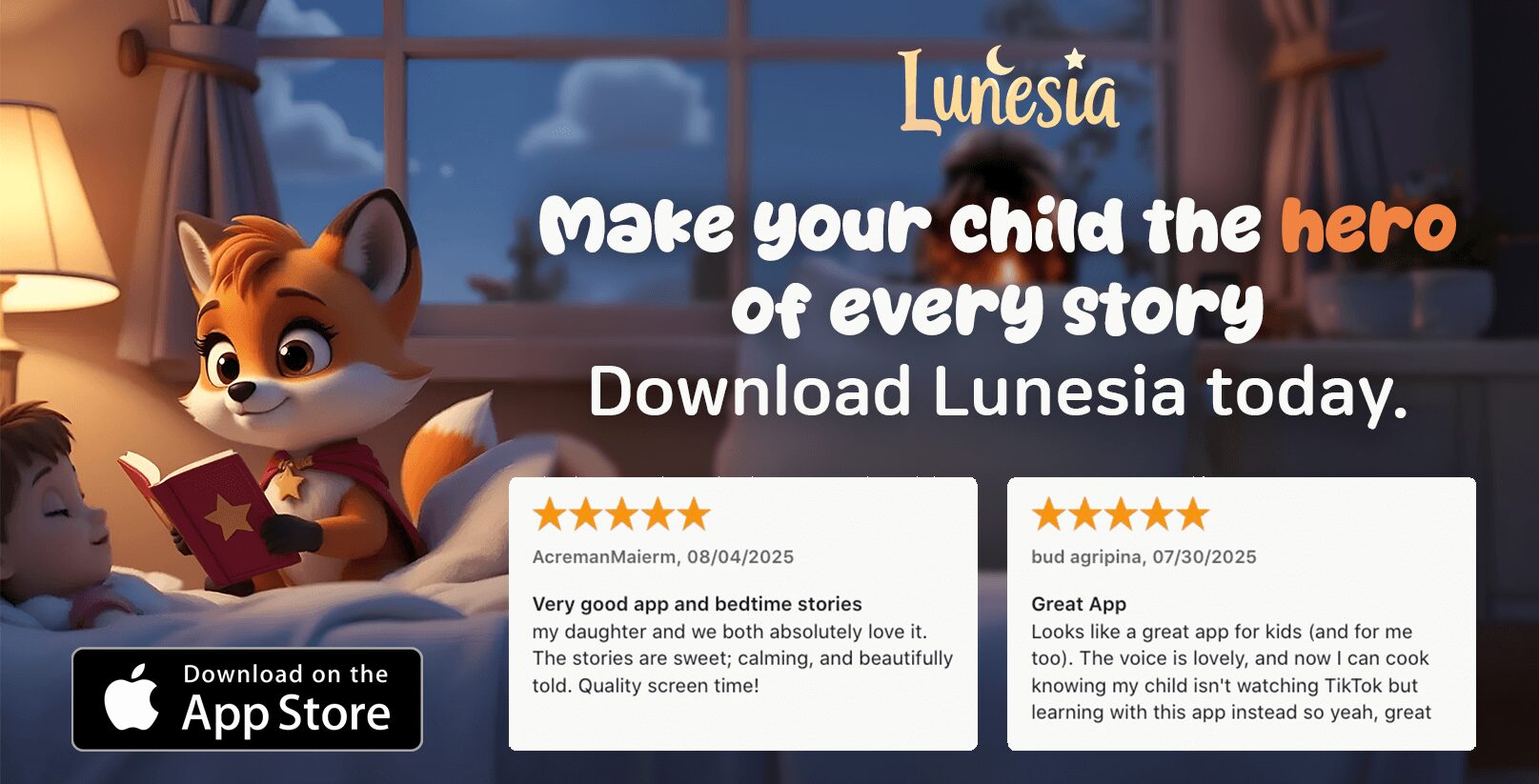The glow of a screen, a seemingly innocuous part of modern childhood, masks a relentless campaign for your child’s attention, preferences, and ultimately, their developing mind. This is not a passive pastime; it is a battleground where sophisticated psychological tactics are deployed with scientific precision.
Advertisers are projected to spend a staggering $21.1 billion by 2031 specifically targeting children.1 This colossal investment underscores a deliberate and strategic intent, far removed from accidental exposure. It is a calculated effort to influence young minds, predicated on achieving returns by shaping their desires and behaviors.
By the time they reach 21, an average young person will have been subjected to over one million advertisements 1, a significant and rapidly growing portion of which are delivered digitally, often bypassing parental awareness and oversight. The sheer volume is overwhelming; one estimate suggests that many 14-year-olds are exposed to as many as 1,260 ads daily on social media platforms alone.2 This constant barrage forms the bedrock of a concerning reality: children’s mental environments are becoming saturated with commercial messaging, potentially displacing crucial developmental inputs like play, interactive learning, and genuine social connection.
This report will demonstrate, with irrefutable scientific backing, how platforms like TikTok, YouTube, and Instagram are not merely “showing ads.” They are actively employing sophisticated techniques that can, and do, alter a child’s developing brain, their psychological state, and ultimately, their behavior.
This is not hyperbole; it is a documented concern voiced by researchers, child psychologists, and international health organizations. The core argument is that the impact transcends simple product preference; it involves a fundamental “rewiring” process. This report cuts through the noise, presenting undeniable scientific evidence. It aims to be “sidérant mais toujours vrai” – staggering but true – empowering parents with the knowledge to understand this pervasive threat and the concrete actions needed to protect their children before their attitudes and behaviors are irrevocably changed.
Chapter 1: Decoding the Digital Pied Piper: How They Lure Your Child In
The digital landscape, vibrant and engaging on the surface, operates with an underlying architecture designed to captivate and influence its youngest users. Understanding how this “Digital Pied Piper” works is the first step for parents to effectively shield their children. This involves recognizing children’s inherent vulnerabilities, the mechanisms of algorithmic targeting, and the specific persuasive tactics employed.
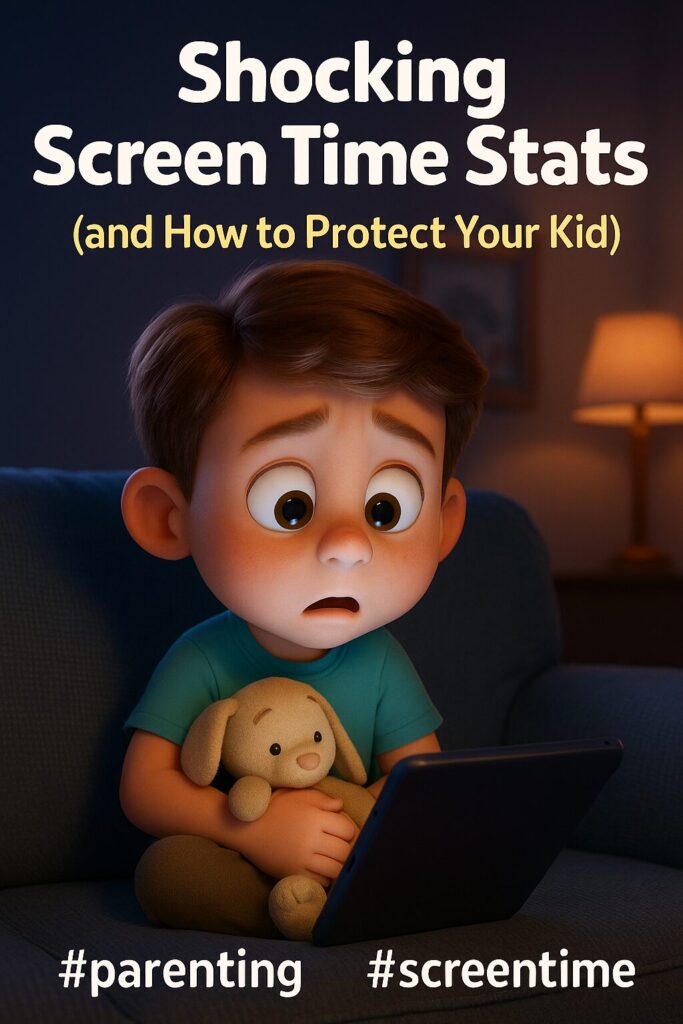
Section 1.1: The Unprotected Mind: Why Children are Prime Targets
Children are not miniature adults; their minds are still under construction, making them uniquely susceptible to the persuasive power of advertising. This vulnerability is not a flaw, but a developmental stage that advertisers have become adept at exploiting.
Cognitive Immaturity – The Open Door:
The developing brain of a child, particularly those under the age of eight, lacks the sophisticated cognitive architecture to fully comprehend the persuasive intent behind advertising messages. According to Piagetian theories of cognitive development, children progress through distinct stages of understanding3 Younger children, especially, cannot reliably distinguish advertisements from entertainment content. The American Psychological Association has stated unequivocally that “children under the age of eight are unable to critically comprehend televised advertising messages and are prone to accept advertiser messages as truthful, accurate and unbiased”.7This means they often perceive ads as simple, factual information or harmless fun, rather than sophisticated attempts to influence their desires and actions.
This cognitive vulnerability extends well into adolescence. Research indicates that critical reasoning abilities and the capacity to resist advertising, particularly the subtle and embedded forms found in digital media, may not fully develop until the age of 16 or even later.3 A systematic review published in Pediatrics concluded that “Critical reasoning abilities did not appear to be fully developed during adolescence and not found to be protective against the impact of advertising”.3 The common assumption that teenagers are savvy enough to be immune to these influences is a dangerous misconception. Indeed, “Young people are exposed to an abundance of advertising for unhealthy products… Because of their developing cognition, children may not be able to understand the intent of advertising”.3 This fundamental lack of “advertising literacy”—the knowledge and understanding of advertising intent and tactics—leaves them as easy targets.3
Emotional Decision-Making:
Compounding their cognitive immaturity is the fact that children’s decision-making processes are heavily driven by emotion rather than rational analysis. Digital advertisements are increasingly designed to bypass conscious, logical thought and appeal directly to these powerful emotional responses.
As one study notes, “Advertising, especially when digitally embedded, is designed to bypass conscious and rational decision-making and instead rely on emotional responses and unconscious processing, thereby inhibiting the ability to resist effectively”. This emotional susceptibility is exploited from an astonishingly early age. Research suggests that brand relationships can begin forming as early as six months, with definitive brand loyalty potentially starting by age two. These early preferences are often built on emotional connections and nostalgic ties, demonstrating how deeply and quickly these emotional hooks can be set, long before a child can critically evaluate the message or product.
The evolution of advertising from explicit 30-second television commercials to “blurred,” “native,” and “influencer-driven” content is a direct exploitation of children’s documented inability to discern persuasive intent in less obvious formats. The more seamlessly an ad is integrated into entertainment, the less likely a child is to recognize it as a commercial message, let alone critique its underlying motive.3 Platforms like TikTok even advise brands to create content that looks less like ads, a clear strategy to circumvent the developing cognitive defenses of young users.10
Section 1.2: The Algorithmic Net: Personalized Manipulation at Scale
The effectiveness of digital advertising in targeting children is massively amplified by the relentless collection of personal data and the sophisticated algorithms that use this data to deliver hyper-personalized manipulative content.
Data Collection – The Fuel for the Fire:
Social media platforms like TikTok, YouTube, and Instagram are not merely entertainment venues; they are powerful data-harvesting operations. “Data about all social media users, including children, is extracted so that they can be targeted more accurately with similar adverts”. The extent of this data collection is staggering. Even seemingly innocuous interactions, such as looking at one advertisement for “a fraction of a second longer than another generates information about a child’s preferences”.
This data encompasses a vast array of user activities: videos liked, shared, or commented on, accounts followed, video details like captions, hashtags, and sounds, as well as device and account settings such as language preferences, device type, and location.
The scale of this surveillance is almost beyond comprehension. One report estimates that “the global adtech industry accumulates approximately 72 million data points on the average child by the age of 13”.8 This creates what experts call an “unprecedented degree of asymmetry” between the sophisticated persuasive tactics employed by advertisers and a child’s limited ability to comprehend or resist them.8 This isn’t passive data gathering; it’s an active, ongoing process to refine persuasive techniques in real-time, making each subsequent ad potentially more potent for that specific child.
Algorithmic Targeting – The Perfect Trap:
The vast quantities of data collected are the lifeblood of targeting algorithms. These complex computational systems analyze user data to create highly personalized content feeds, including advertisements, designed to keep users, especially children, “hooked”. As succinctly put, “algorithms are like big sorting machines they sort everybody into different buckets and once you’ve been sorted you’re treated like everybody else in that bucket”.
This means the algorithm makes numerous assumptions about who your child is and what they desire.
TikTok’s algorithm, for instance, is renowned for its ability to match content to individual viewers’ interests by analyzing detailed behavioral data, such as how long users watch particular categories of videos, which specific sounds or music tracks capture their attention, and the types of creators they engage with.12 This allows advertisers to pinpoint audiences who have demonstrated interest in related content with remarkable accuracy. Consequently, the ads a child sees are not random; they are meticulously selected and delivered based on a deep, algorithmically-derived profile of their inferred desires, emotional triggers, and even their vulnerabilities. This creates a powerful feedback loop: more data leads to more refined algorithms, which in turn leads to more effective and often more manipulative targeting.

Section 1.3: The Marketer’s Toolkit: Unmasking the Tactics
Armed with data and sophisticated algorithms, marketers deploy a wide array of persuasive techniques specifically designed to engage children, bypass their critical faculties, and drive consumption. These tactics often blur the lines between entertainment and advertising, making them particularly insidious.
Persuasive by Design – Engineering Addiction and Engagement:
The very interfaces of social media platforms are engineered to maximize engagement and, by extension, ad exposure. This is achieved through “persuasive design,” where digital environments are intentionally constructed to “capture users’ attention and hold it for as long as possible”. Common techniques include:
- Auto-play features: Seamlessly transitioning from one video to the next, reducing the cognitive load required to continue watching.
- Infinite scrolling: Providing an endless stream of content that discourages disengagement.
- Variable reward schedules: Unpredictable notifications, likes, and comments trigger dopamine releases in the brain, creating a compulsion to check for new interactions and rewards, akin to a slot machine.14
- Streaks (e.g., Snapchat’s Snapstreaks): Encouraging daily interaction to maintain a virtual “streak,” fostering a sense of obligation and fear of loss.15
These design elements are not accidental; they are carefully crafted to exploit basic human psychology, and children, with their developing impulse control, are particularly vulnerable.14
Blurred Lines (Stealth Advertising):
A critical danger for children is the increasing prevalence of “stealth advertising,” where commercial messages are embedded within or disguised as entertainment content, making them difficult to identify. This deliberate blurring exploits children’s inability to distinguish ads from other content. Examples include:
- Advergaming: Advertisements are woven directly into online games. Children might play a game featuring branded characters or requiring the use of branded virtual items, effectively engaging with an ad for extended periods without necessarily recognizing it as such.9 The Fairplay report “Buying to Belong” details how popular social video game platforms like Fortnite and Roblox use monetization strategies, including virtual assets and in-game purchases, that are designed to exploit adolescents’ developmental needs for social connection and creative expression.17
- Unboxing Videos: Popular on YouTube, these videos often feature children or influencers opening new toys or products. While seemingly organic, many are sponsored, effectively turning children into advertisers themselves.9
- Native Advertising: Brands create paid content that mimics the look, feel, and style of user-generated content “native” to the platform.10 This makes the ad feel more authentic and less like a traditional commercial. TikTok explicitly advises brands to “stop making ads” and instead collaborate with content creators, utilizing the platform’s creative features and its “For You” algorithm to tailor-make content that blends seamlessly with organic posts.10
- Branded Hashtag Challenges: Brands initiate or capitalize on viral challenges, encouraging users (often children) to generate content that promotes their brand or product, effectively turning users into unpaid marketers.10
Dark UX Patterns:
Beyond persuasive design, platforms and advertisers sometimes employ “Dark UX (User Experience) Patterns”—design choices that intentionally trick or manipulate users into actions they didn’t intend. The Federal Trade Commission (FTC) has warned about these tactics, especially concerning their impact on young users whose executive function skills are still developing. Examples include:
- Bait and Switch: Advertising a game with exciting, complex gameplay, while the actual game is much simpler or different.
- Misdirection: Using fake “X” buttons on ads that, instead of closing the ad, redirect the user to an app store page.
- Forced Continuity: Making it difficult to close an ad by using tiny, hard-to-see close buttons or delaying their appearance.
- Disguised Ads: Ads designed to look like system notifications or part of the app’s regular interface.
The Influencer Illusion – Friends for Hire:
Influencer marketing is a particularly potent tactic because it leverages “parasocial relationships”—the one-sided sense of friendship or connection that viewers develop with media personalities.15 Children, who naturally seek connection and role models, often come to trust these influencers as they would real-life friends. This perceived authenticity makes their endorsements highly persuasive.
- A UNICEF report identified various types of influencers marketing (often unhealthy) food to children, including mega-influencers (celebrities with millions of followers), child influencers (who have high credibility with peers), and “mommy influencers” (mothers sharing family-related content).11
- Disclosures indicating that content is sponsored (e.g., #ad) are often “inadequate—either because the disclosures themselves are unlikely to be seen…and evaluate an embedded ad”.9 Even when a child notices a disclosure, a strong parasocial bond with the influencer can override their skepticism about the selling intent.22
Emotional Exploitation & Neuromarketing – Playing with Feelings:
Given children’s reliance on emotional processing, many ads are meticulously crafted to evoke specific feelings. Food and beverage ads, for example, aim to communicate “excitement and energy,” “youthfulness, exclusivity, urban chic and being cool,” or “tasty and fun” experiences, associating the product with pleasure and happiness.
- FOMO (Fear of Missing Out): Social media platforms are breeding grounds for FOMO, as users are constantly exposed to the curated highlights of others’ lives.29 Advertisers capitalize on this by showcasing products or experiences that imply users will be left out or less cool if they don’t participate.31
- Neuromarketing: This emerging field applies neuroscience principles to advertising to “evoke subconscious emotional responses that drive consumer behaviour”.8 These techniques aim to bypass critical thought entirely, directly targeting the brain’s emotional and decision-making centers. The use of neuromarketing on children is particularly concerning because it “exploits children’s vulnerabilities for commercial gain” at a fundamental, often unconscious, level.8
- Surveillance Advertising: This is the dangerous culmination of massive data collection (as discussed in Section 1.2) and sophisticated psychological profiling. It allows for the delivery of hyper-personalized ads designed to trigger specific emotional responses in individual children, maximizing manipulative power.8
The “Digital Pied Piper” is not a single entity but a complex, interconnected ecosystem of platforms, advertisers, data brokers, and influencers. This system, largely operating outside direct parental awareness and often beyond effective regulatory control 32, has become incredibly efficient at persuading and manipulating children.
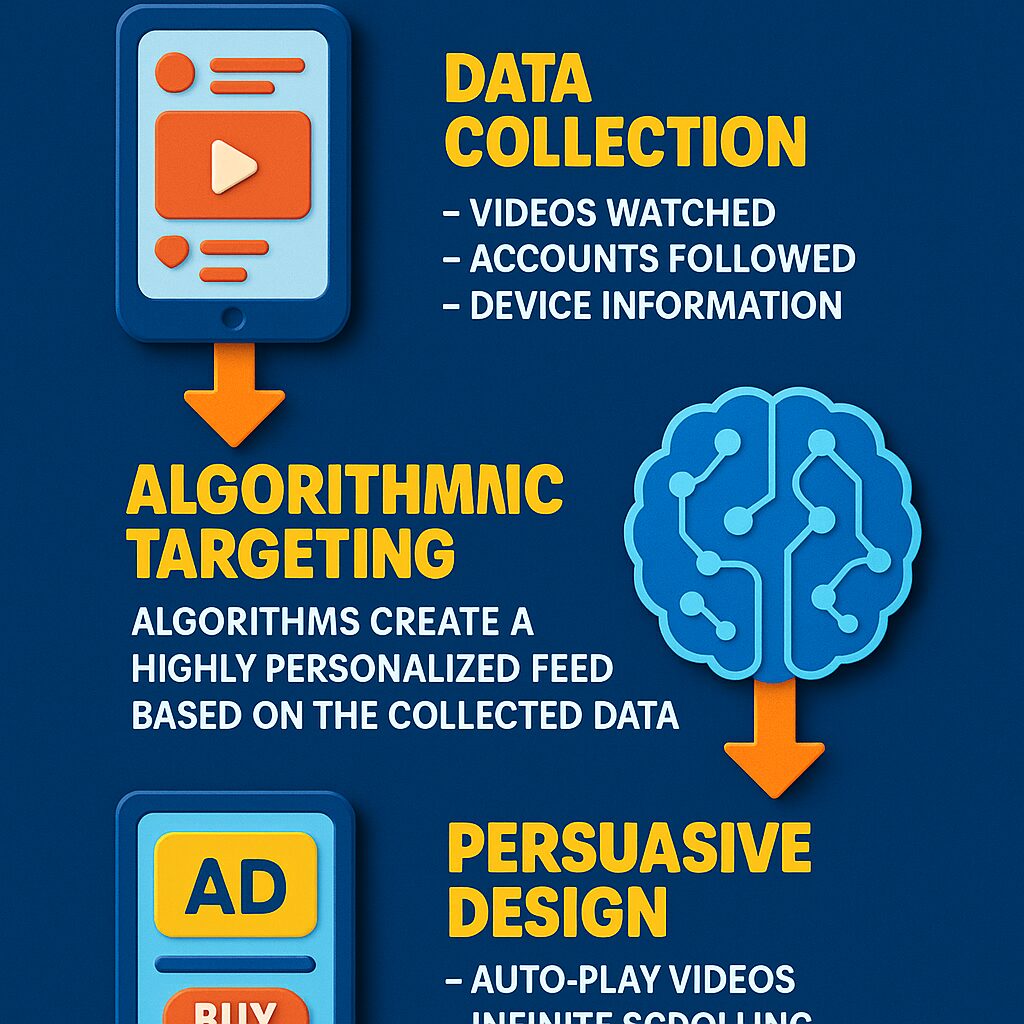
Table 1: The Digital Pied Piper’s Playbook: How Ads on TikTok, YouTube & Instagram Target Your Child
| Manipulative Tactic | How It Works (The Science of Deception) | Platform Example (TikTok, YouTube, Instagram) | Why It’s So Effective on Developing Brains | Key Supporting Evidence |
| Algorithmic Targeting | Uses personal data (likes, watch time, location) to predict desires & vulnerabilities, creating personalized ad feeds. | TikTok’s ‘For You’ page tailoring ad content based on intricate user behavior analysis. | Hyper-personalized to the individual child’s inferred interests and emotional triggers, making ads feel uniquely relevant and harder to ignore. | 11 |
| Influencer Marketing | Leverages trust and parasocial bonds (illusion of friendship) with media personalities. | YouTube ‘kidfluencers’ unboxing toys or child gamers promoting products. | Exploits children’s natural trust in “friends” and role models; persuasive intent is masked by the perceived authenticity of the influencer. | 11 |
| Persuasive Design (Autoplay, Notifications, Streaks) | Creates compulsion loops, triggers dopamine releases, encourages prolonged and repeated use. | Instagram’s infinite scroll with interspersed sponsored posts; Snapchat streaks. | Overwhelms limited self-regulation and impulse control; fosters habitual checking and fear of missing out. | 11 |
| Advergaming / In-App Purchases / Loot Boxes | Blurs lines between play and persuasion; exploits reward-seeking behavior and desire for virtual status. | In-game currency ads on YouTube gaming streams; pop-up offers for loot boxes in mobile games. | Children often cannot distinguish ads from the game itself; strong desire for rewards can lead to impulsive spending. | 17 |
| Emotional Appeals (FOMO, “Cool Factor,” Humor) | Bypasses rational thought by linking products to strong positive or negative emotions. | Snack ads on Instagram showing ‘cool’ teens having fun; game ads creating urgency. | Children are highly susceptible to emotional cues and social pressure; decisions are often affect-driven rather than logic-based. | 11 |
| Blurred / Stealth Ads (Native Advertising) | Disguises commercial intent by making ads look like regular entertainment content. | Product placement in popular YouTube vlogs; sponsored articles that resemble editorial content. | Children lack the cognitive ability to identify the persuasive intent when it’s not explicit, viewing ads as entertainment or information. | 3 |
This table provides a snapshot of the multifaceted strategies employed. Each tactic, while distinct, often works in concert with others, creating a powerful and pervasive web of influence that developing minds are ill-equipped to navigate.
Chapter 2: The Neurological & Psychological Scars: What Science Reveals
The constant barrage of sophisticated advertising on platforms like TikTok, YouTube, and Instagram is not a harmless distraction. Mounting scientific evidence, including cutting-edge neuroimaging studies, reveals that these digital experiences can leave tangible neurological and psychological scars on developing brains.
This chapter delves into what science shows about how these platforms hijack brain reward systems, contribute to mental health issues, impair cognitive functions, and specifically manipulate children towards unhealthy choices.

Section 2.1: Hijacking the Brain’s Reward System: The fMRI Evidence
The human brain, particularly during adolescence, is highly attuned to social rewards and feedback. Social media platforms are meticulously designed to tap into this fundamental neural circuitry, and advertising seamlessly integrates into this reward-driven ecosystem.
The Allure of Social Rewards and Brain Development:
Adolescence is a period of significant brain maturation, especially in regions crucial for social understanding, emotional processing (like the amygdala), and cognitive control. Social media use, laden with advertisements, directly interacts with these sensitive developmental windows.
Features like the “like” button, comments, and shares act as powerful reward mechanisms. The anticipation and receipt of such social feedback activate key reward processing areas in the brain, including the amygdala, the ventromedial prefrontal cortex (vmPFC), and the ventral striatum. This constant stimulation can motivate users, especially young ones, to continually adjust their online behavior to maximize these rewards, creating a powerful reinforcement loop.
UNC-Chapel Hill Study 39: A Bombshell Finding:
A landmark longitudinal study from the University of North Carolina at Chapel Hill provided some of the first direct evidence of how social media habits can alter adolescent brain development. Researchers tracked 169 adolescents, starting at ages 12-13, over three years. Using fMRI brain scans, they measured brain activity while the teens anticipated social feedback from peers. The findings were startling: adolescents who reported habitually checking social media (more than 15 times per day) showed distinct changes in their brain’s developmental trajectory. Specifically, their brains became more sensitive when anticipating both social rewards (like praise) and social punishments (like criticism).
Eva Telzer, a professor in UNC-Chapel Hill’s psychology and neuroscience department and a corresponding author of the study, stated, “The findings suggest that children who grow up checking social media more often are becoming hypersensitive to feedback from their peers”.39 Co-author Mitch Prinstein, chief science officer for the American Psychological Association, emphasized the gravity: “Our research demonstrates that checking behaviors on social media could have long-standing and important consequences for adolescents’ neural development, which is critical for parents and policy-makers to consider”.39 Kara Fox, another co-lead author, explained the mechanism: “These social inputs are frequent, inconsistent and often rewarding, making them especially powerful reinforcers that can condition users to check social media repeatedly”.39 This hypersensitivity can make children more vulnerable to the social pressures and comparisons inherent in many forms of advertising, especially influencer marketing.
Food Logos & Brain Activation 40:
The brain’s reward system isn’t just triggered by social interactions; it also responds to commercial cues. An fMRI study on healthy children examined their neural responses to common food and non-food logos. The results showed that food logos, when compared to a baseline or non-food logos, prompted increased activation in brain regions known to be associated with motivation and reward, including the orbitofrontal cortex, inferior prefrontal cortex, and posterior cingulate cortex.40 The researchers noted this was the “first study in children to examine brain responses to culturally familiar logos,” highlighting that even simple exposure to branding can engage these powerful neural pathways, potentially driving desire and preference from a very young age.40
These fMRI findings collectively paint a concerning picture. The adolescent brain, already undergoing critical development in social and emotional processing areas, is being uniquely shaped by the reward structures of social media. Advertising, often designed to mimic social cues or promise social acceptance, can therefore have a more profound and potentially altering impact on a brain that is becoming increasingly sensitive to these very signals. Furthermore, frequent screen media consumption, which includes ad exposure, has been linked to a less efficient cognitive control system in adolescence 41, potentially reducing a child’s ability to regulate their responses to these potent stimuli.
Section 2.2: The Rising Tide of Anxiety, Depression, and Poor Self-Esteem
The psychological toll of constant digital immersion and ad exposure on children and adolescents is becoming increasingly undeniable, with numerous studies linking frequent social media use to a spectrum of mental health challenges.
The Statistical Nightmare:
The correlation between heavy social media use and negative mental health outcomes in youth is robust. Multiple studies and reviews confirm that frequent use is “strongly associated with lower self-esteem, depressive symptoms, anxiety, and other mental health challenges in children”.42 A significant meta-analysis found that children who spend more than two hours per day on social media are at a “significantly higher risk of experiencing symptoms of anxiety and depression compared to their peers with limited screen time”.42 Echoing this, the U.S. Surgeon General issued an advisory stating that teenagers who spend more than three hours a day on social media double their risk of experiencing depression and anxiety symptoms.43
Furthermore, excessive social media use, often extending late into the night, is linked to poor sleep quality.42 Sleep deprivation is a well-established contributor to mood disorders. A longitudinal study specifically demonstrated that children who frequently engage with social media before bedtime are more likely to experience sleep disturbances, which in turn contribute to elevated anxiety levels.42
Mechanisms of Harm:
Several interconnected mechanisms explain how advertising-laden social media environments contribute to these negative psychological outcomes:
- Social Comparison: Social media platforms are inherently stages for self-presentation, where users typically showcase idealized versions of their lives. Dr. Kate Eshleman, a child psychologist at Cleveland Clinic, explains, “Social media makes it easy to compare oneself to another. Most people put on social media what they want you to see…This results in likely comparing oneself to an artificial image, and distress can result if we feel we don’t measure up”.43 Research indicates that passive consumption of social media content (merely viewing others’ posts) is particularly likely to provoke social comparisons, leading to lower self-esteem and increased anxiety.42 Advertisements, especially those featuring attractive, successful, or popular individuals, intensify this comparison trap.
- Body Image Crisis: The relentless stream of curated images from influencers and advertisements promotes unrealistic beauty standards. This has a devastating impact on young people’s body image, contributing to body dissatisfaction, disordered eating, and low self-esteem.6 Statistics are alarming: one report indicates that “46% of teens aged 13-17 feel worse about their bodies because of social media”.43
- Cyberbullying: While not a direct form of advertising, the platforms where ads are displayed are often rife with cyberbullying. Exposure to online harassment is strongly linked to increased social anxiety and depressive symptoms in children.42 The pervasive nature of social media means that bullying is no longer confined to school hours but can follow a child constantly.
- Fear of Missing Out (FOMO): The curated perfection displayed on social media, often amplified by advertising that showcases desirable products and experiences, fuels a pervasive “Fear of Missing Out”.29 This constant anxiety about being excluded or not keeping up can lead to increased stress and may even drive children towards risky behaviors in an attempt to fit in or gain social validation.31
The neurological changes discussed earlier, such as heightened sensitivity to social feedback 39, likely exacerbate these psychological harms. A brain primed for social validation becomes even more susceptible to the pressures of social comparison and the allure of products advertised as pathways to acceptance or happiness. This creates a damaging feedback loop where the platform and its ads both trigger and prey upon these psychological vulnerabilities.
Section 2.3: Cognitive Impairment: Dulling the Mind
Beyond the emotional and psychological impact, the nature of engagement with ad-filled digital media can also impair crucial cognitive functions in children and adolescents, affecting their ability to focus, think critically, and make sound decisions.
Attention Deficits & Impulsivity:
The fast-paced, constantly shifting nature of content on platforms like TikTok and YouTube, interspersed with dynamic ads, can take a toll on attention spans. Research has associated extensive smartphone and internet exposure, along with media multitasking (simultaneously engaging with multiple forms of media), with higher impulsivity and cognitive inflexibility, particularly in girls.
One study highlighted that “one additional hour of smartphone and internet exposure daily were associated with higher impulsivity score”. This increased impulsivity and reduced ability to flexibly shift attention between tasks “may adversely impact youth’s ability to shift between tasks” and consequently lead to poorer academic performance.
Erosion of Critical Thinking:
As established in Chapter 1, children possess limited cognitive abilities to understand the persuasive intent of advertising, especially in its subtle digital forms.3 The constant bombardment with manipulative content, often designed to “bypass conscious and rational decision-making” 3, actively discourages the development and application of critical thinking skills. When advertising relies on emotional responses and unconscious processing, it conditions the brain to react rather than reflect.
Over time, this can erode a child’s capacity for critical evaluation, making them more susceptible to misinformation and manipulation not just from ads, but in other areas of life as well.
Impact on Decision-Making:
The same research that linked smartphone exposure and media multitasking to impulsivity also found an inverse association (though not always reaching statistical significance across all measures) with decision-making ability.
The constant “nudging” by persuasive design elements in apps and the emotionally charged appeals in advertisements can condition children to make impulsive, affect-driven choices rather than considered, rational ones. This pattern of decision-making, honed in the digital realm, can easily spill over into real-world choices with significant consequences.
The documented impact on attention, critical thinking, and decision-making creates a concerning scenario: the very tools designed to manipulate children (digital ads and platforms) may simultaneously be diminishing the cognitive capacities children need to defend themselves against such manipulation. This creates a self-reinforcing cycle of vulnerability, where each exposure potentially makes the child less equipped to resist the next.
Section 2.4: The Unhealthy Food Trap: A Case Study in Manipulation
The marketing of unhealthy food and beverages to children via social media provides a stark and well-documented example of how these platforms are used to manipulate young minds and bodies, with serious long-term health consequences.

Ubiquitous Junk Food Ads:
Children are not just seeing a few unhealthy food ads; they are “bombarded with social media ads for junk food”. An Oxford University study revealed that some children were exposed to junk food advertisements nearly 200 times a week while using popular apps like Instagram, TikTok, and YouTube.4
This relentless exposure is far from accidental.
Direct Impact on Preferences and Consumption:
There is “unequivocal research evidence that food marketing affects children’s food and beverage preferences, requests, purchases and consumption”.
This influence manifests in various ways, including increased requests to caregivers for advertised products, a phenomenon known as “pester power”.5 Adolescents, in particular, actively engage with unhealthy food marketing; evidence shows they look longer at ads for unhealthy items, share them more, prefer peers with unhealthy content in their social media, and remember unhealthy brands more readily.
Sophisticated Tactics 11:
A UNICEF report, analyzing thousands of social media marketing posts, detailed the sophisticated tactics used by food and beverage companies :
- Influencer Marketing: This is a primary channel, utilizing mega-influencers, child influencers (who are highly credible among peers), “mommy influencers,” and even “mukbang” influencers (who engage in food bingeing of unhealthy items on video). These influencers provide a direct line to children eager to emulate their role models.
- Targeted Messaging: Adverts deploy specific messaging strategies:
- “Cool Crowd”: Associating products with excitement, energy, youthfulness, exclusivity, and being “cool,” often using bright graphics, strong colors, and references to popular culture (e.g., “While watching variety shows, don’t forget to match it with this cool ice cream.”).11
- “Tasty and Fun”: Focusing on flavor, indulgence, fun, and positive emotions, linking the food with pleasure (e.g., “Hot and sweet. You can feel happiness only when you put it in your mouth.”).11
- “Family Harmony”: Emphasizing family togetherness and happiness, often featuring cheerful family scenes.
- “Active Life”: Misleadingly implying health benefits or energy provision, despite the unhealthy nature of the products, often using sporty imagery.
- Persuasive Design: Ads are designed to appear as children browse, watch videos, or follow celebrities. Clicking one ad can trigger a cascade of similar ads for weeks. Even a fraction of a second longer spent looking at an ad provides valuable preference data.11
Long-term Consequences:
The impact of this pervasive marketing is profound and lasting. “Food marketing creates a desire for highly processed products and life-long brand allegiances starting from an early age before children have developed knowledge about food and nutrition”.11 This directly contributes to the escalating crisis of childhood obesity.6 The UNICEF report grimly projects that “by 2030, it is estimated that 83 million children of school age will be living with obesity in East Asia and Pacific” alone.11
Researchers are clear about the manipulative nature of these practices. Jesse Lafontaine, lead author of the Oxford study, stated, “Many children do not realise they are being targeted by advertising when they see influencers, celebrities, or brands promoting food online… food companies are using this to push unhealthy products in ways that are difficult to spot. This is making it harder for children and young people to make healthy choices”.48 Dr. Isabel Hanson, another author on the study, added that industry self-regulation is failing: “These self-imposed rules are failing… Self-regulation is not enough, and the marketing of unhealthy food is as widespread as ever”.48
The combination of neurological changes making children more reward-sensitive, widespread psychological distress fueled by social comparison, cognitive impairments reducing critical thinking, and the specific, aggressive targeting with unhealthy food ads points to a multi-faceted public health crisis. This is not merely about individual children making “bad choices”; it is about an environment systematically engineered to shape them towards negative health and behavioral outcomes, with potentially immense long-term societal costs in healthcare, lost productivity, and diminished overall well-being.

Chapter 3: The Behavioral Meltdown: When Online Manipulation Spills into Real Life
The neurological and psychological impacts of relentless digital advertising do not remain confined to the child’s inner world. They inevitably manifest in observable behaviors, as the manipulated desires, distorted perceptions, and conditioned responses fostered online spill over into daily interactions, choices, and habits.
This chapter examines how the constant commercial pressure cultivates materialism, leads to tangible harms like financial exploitation and addiction, normalizes risky behaviors, and creates a distorted view of reality that can profoundly affect a child’s life trajectory.
Section 3.1: From “Wanting It” to “Needing It”: The Cultivation of Materialism
The primary goal of advertising is to create desire, and in children, this desire can quickly morph into a perceived need, fostering materialistic values from a very young age.
Early Brand Recognition & Loyalty:
The seeds of consumerism are sown remarkably early. Children begin to develop brand-product associations long before they can fully comprehend complex marketing messages.1 Research indicates that “brand relationships begin forming as early as six months, with brand loyalty potentially starting by age two”.8 These early loyalties are often forged through emotional connections—a catchy jingle, a beloved character, or the association of a product with fun and happiness.
Once these positive emotional associations with brands are established, they can prove “quite difficult to change, especially when formed at an early age when children’s brains are more malleable”.1
Advertising’s Link to Materialistic Values:
There is substantial evidence supporting the hypothesis that consistent exposure to advertising makes children more susceptible to materialistic values.1 Influencer culture, a dominant force on platforms like Instagram and TikTok, plays a significant role in this. Influencers often “promote products and expensive lifestyles, making children believe that buying things will make them happy or successful”.
This constant parade of possessions and idealized existences can lead children to equate material goods with self-worth and social acceptance. Childhood materialism, in turn, has been linked with a host of negative outcomes, including a higher risk of future overspending and debt, and undesirable character traits such as self-centeredness and entitlement.1
“Pester Power” – The Child as Salesperson:
Advertisements targeting children are often explicitly designed to leverage “pester power”—the tendency for children to repeatedly ask their parents for products they’ve seen advertised.5 This is not an accidental byproduct but a documented marketing strategy.5 As one marketing executive candidly admitted, “The way to reach kids is not to sell to Mom but to use ‘pester power’ to have the kids themselves act as the salesperson”.
This tactic not only drives sales but can also become a significant source of family conflict when parents deny their children’s ad-fueled requests.4 The child, influenced by persuasive messaging they cannot critically evaluate, becomes an unwitting agent for the advertiser within their own home.
Section 3.2: Real Stories, Real Harm: Documented Impacts
The behavioral consequences of online advertising and platform design extend beyond materialism into areas of significant, tangible harm, including financial exploitation and the development of addictive behaviors.
Financial Exploitation – The High Cost of “Free” Games:
The digital marketplace, particularly within “freemium” games and apps, is rife with opportunities for children to incur substantial financial costs, often unknowingly. In-app purchases, virtual currencies, and “loot boxes” (randomized virtual rewards that can be bought with real money) are significant concerns.
The Federal Trade Commission (FTC) took action against HoYoverse, the creators of the popular game Genshin Impact, highlighting how its “multi-tier monetary system… obscures the true amounts that children… spend” and its interface “allows users of all ages to easily and frictionlessly buy and spend hundreds of dollars worth of virtual currency within moments”. The FTC specifically criticized “pay to win” promotions and the low odds of obtaining desirable items from loot boxes, often requiring players to spend hundreds of dollars.

The article “Predatory Teen Marketing—Not Kid’s Stuff” further discusses how “stealth” marketing tactics are used to manipulate vulnerable individuals, including children, into purchasing products.49 While a specific case of a child spending $16,000 isn’t detailed in the provided research for this report, the mechanisms for such significant financial harm are clearly documented.20 The design of these systems often exploits children’s impulsivity, their developing understanding of monetary value, and their desire for in-game status or rewards. There have been numerous anecdotal reports and some documented instances of children unknowingly accumulating thousands of dollars in charges on their parents’ accounts through such in-app purchases, a direct result of game designs that prey on their vulnerabilities.
Behavioral Addiction & Compulsive Use:
The very design of social media platforms and many online games promotes habitual and often compulsive use. Frequent social media engagement has been linked to addictive behaviors.
The immersive nature of these platforms, combined with variable reward schedules (likes, notifications, in-game rewards), creates powerful reinforcement loops that can lead to what is termed “Screen Dependency Disorders” (SDD).11 Research into conditions like Internet Addiction Disorder (IAD) is an emerging neurological concern, with some studies finding associations between SDD and abnormalities in neural tissue and function.
A lawsuit filed against major social media companies, including Meta (Facebook, Instagram), Snap, TikTok, and Alphabet (YouTube), alleges that these platforms were intentionally designed to be addictive and manipulative to maximize user engagement, particularly among minors.51 This suggests that the addictive qualities are not accidental but a feature of the business model.
Normalization of Risky & Inappropriate Behaviors:
The content of advertisements, and the content within which ads are embedded, can significantly shape a child’s understanding of acceptable social norms and behaviors. Exposure to ads featuring unsuitable content—such as violence, prematurely sexualized imagery, or the promotion of unhealthy habits like vaping, alcohol use, or gambling—can warp a child’s perception of what is normal or desirable.
One report chillingly notes, “Prolonged exposure to this sort of material can impact the development of…source and may get them into trouble in their later years”.The American Psychological Association has voiced concerns about beer advertisements commonly shown during sports events, which are viewed by millions of children and can create brand familiarity and more positive attitudes toward drinking in children as young as 9-10 years old. Similarly, ads for violent media products (e.g., movies, video games) can contribute to a violent media culture, potentially increasing aggressive behavior and desensitizing children to real-world violence.
The progression from a child pestering for a toy to a teenager incurring significant debt through in-app purchases, or developing addictive usage patterns, represents an alarming escalation of exploitation, often normalized by the digital environment itself. Children are being conditioned to participate in complex commercial transactions and engage with potentially harmful content without the cognitive or emotional maturity to understand the full implications.
Section 3.3: Distorted Realities: Unrealistic Expectations and Lifestyles
The curated and often commercially driven content on social media and in advertisements paints a picture of life that is frequently far removed from reality, leading to unrealistic expectations and a distorted self-perception among children and adolescents.
The “Perfect Life” Illusion:
Advertisements and influencer content are meticulously crafted to present idealized versions of reality, beauty, success, and happiness. Children are bombarded with images of flawless individuals, luxurious lifestyles, and constant excitement. This relentless exposure can lead to “unreachable expectations, poor self-esteem, and a warped understanding of societal norms”.The gap between these digital portrayals and their own lived experiences can be a significant source of distress.
Impact on Self-Perception:
When children constantly compare their own lives, appearances, and possessions to these highly curated and often unattainable online ideals, it can severely damage their self-esteem and body image.
A study conducted by the University of Warwick found a correlation between increased advertising spending and decreased life satisfaction, suggesting that the constant exposure to ads can make people, including children, feel unhappy and inadequate. The pressure to conform to advertised standards of beauty, popularity, or material success can be overwhelming, creating unnecessary stress and anxiety.
Erosion of Authentic Experiences:
The allure of the digital world, amplified by persuasive advertising and addictive platform design, can lead to excessive screen time. This, in turn, can displace crucial real-life experiences essential for healthy development, such as outdoor play, creative pursuits, face-to-face social interactions, and focused learning.24 When a significant portion of a child’s time and mental energy is consumed by passively engaging with ad-driven content, opportunities for developing essential life skills and authentic self-discovery are diminished.
The behavioral changes observed in children—ranging from increased materialism and family conflict to financial recklessness, addictive tendencies, and a distorted sense of self and reality—are not merely isolated incidents of “kids being kids.” They are often direct, predictable outcomes of prolonged exposure to a digital advertising ecosystem meticulously designed to elicit these very responses. This signals a critical issue where commercial interests are frequently prioritized over the holistic well-being and healthy development of children, necessitating not just individual parental vigilance but a broader societal re-evaluation of these practices.
Table 2: The Domino Effect: From Online Ads to Real-World Behavioral Changes
| Online Ad Exposure/Tactic | Psychological/Cognitive Impact (The “Rewiring”) | Observable Behavioral Change in Child | Potential Long-Term Consequences | Key Supporting Evidence |
| Constant Junk Food Ads (Social Media, YouTube) | Conditioned cravings, unhealthy brand loyalty, emotional association with unhealthy foods. | Increased demand for sugary/fatty snacks, “Pester Power” for specific brands, preference for processed foods over healthier options. | Childhood obesity, poor nutritional habits lasting into adulthood, increased risk of diet-related diseases (e.g., type 2 diabetes). | 11 |
| Influencer Lifestyle & Product Marketing (Instagram, TikTok) | Fosters materialism, social comparison, Fear of Missing Out (FOMO), desire for status symbols. | Obsession with specific brands/products endorsed by influencers, dissatisfaction with own possessions, desire to emulate influencer lifestyles. | Chronic unhappiness, potential for debt due to pursuit of material goods, distorted values, poor financial literacy. | 1 |
| In-Game Purchase Prompts, Loot Boxes, Advergaming | Triggers brain’s reward system, exploits impulsivity and poor understanding of real-money value, creates compulsion loops. | Compulsive gaming, spending allowance (or parents’ money) on virtual items without full comprehension, frustration if unable to purchase. | Gambling-like addiction patterns, significant financial loss for families, development of unhealthy spending habits. | 6 |
| Ads Normalizing Risky Behavior (e.g., Vaping, Alcohol, Extreme Challenges) | Desensitization to risk, skewed perception of social norms, positive association with risky products/activities. | Increased interest in or experimentation with risky behaviors seen online, mimicking of adult behaviors or dangerous online challenges. | Substance use/abuse, accidental injury, legal issues, long-term health problems associated with promoted unhealthy behaviors. | 7 |
| Idealized Beauty/Social Standards in Ads & Influencer Content | Lowered self-esteem, negative body image, heightened social anxiety, constant self-comparison. | Withdrawal from social situations, excessive focus on appearance, seeking validation online, anxiety about not “measuring up.” | Eating disorders, chronic mental health issues (depression, anxiety disorders), difficulty forming authentic relationships. | 6 |
This table illustrates the concerning trajectory from specific online advertising exposures to tangible, often harmful, behavioral outcomes and significant long-term risks. It underscores the critical need for parental awareness and intervention to disrupt this domino effect.
Chapter 4: Your Counter-Offensive: Empowering Your Child in a Digital World
The preceding chapters have laid bare the sophisticated and often predatory nature of digital advertising targeting children. While the scale of this challenge can seem daunting, parents are not helpless bystanders. Armed with awareness and equipped with effective strategies, it is possible to build a robust “digital shield” around children, fostering resilience and promoting healthier engagement with the online world. This chapter outlines actionable steps parents can take, moving from understanding the threat to actively countering its influence.
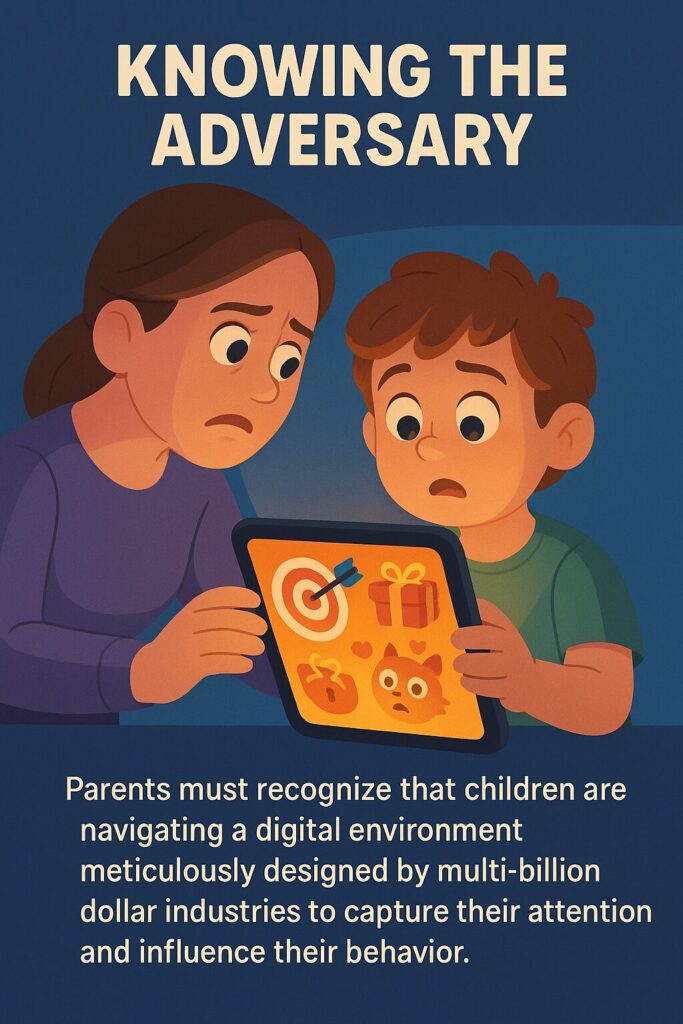
Section 4.1: Arming with Awareness: Knowledge is Power
The first and most crucial step in any counter-offensive is understanding the adversary and the terrain. Parents must recognize that their children are navigating a digital environment meticulously designed by multi-billion dollar industries to capture their attention and influence their behavior. Key vulnerabilities in children include their cognitive immaturity, which makes it difficult for them to discern advertising’s persuasive intent 3; their tendency towards emotional rather than rational decision-making, which ads are crafted to exploit 3; and the ongoing development of their brains, particularly the reward and self-regulation centers, which are highly susceptible to the manipulative designs of social media and games.14
It is vital for parents to understand that their child’s susceptibility is not a personal failing but a consequence of these sophisticated tactics targeting normal developmental stages. This knowledge is not intended to induce blame but to empower parents to become informed and proactive defenders of their children’s well-being.
Section 4.2: Actionable Parental Strategies: Building a Digital Shield
A multi-pronged approach, combining open communication, structured environments, technological safeguards, and positive role modeling, can significantly mitigate the negative impacts of digital advertising.
The Power of Conversation – Fostering Media Literacy:
Open and ongoing dialogue is perhaps the most powerful tool in a parent’s arsenal. Research consistently shows that active parental mediation—engaging with children about the media they consume—significantly improves their critical thinking skills and their ability to resist advertising’s persuasive pull.
- Active Mediation and Co-Viewing with Commentary: Simply watching alongside a child is not enough; parents should engage in “co-viewing with commentary”.53 This involves discussing the content, including any advertisements, as it is consumed. Ask questions like, “What do you think that ad is trying to make you feel or do?” or “Do you think what they’re showing is real?”.29
- Deconstructing Ads Together: Teach children the basic principles of advertising. Help them identify who created the message, what product or idea is being sold, what techniques are being used to capture attention (e.g., bright colors, catchy music, humor, celebrity endorsements), and what the ad wants the viewer to do or believe.54 Organizations like MediaSmarts (Canada) and Media Smart UK offer valuable resources and lesson plans for parents and educators on advertising literacy.57
- Discussing Influencer Authenticity: It’s crucial to help children understand that social media influencers are often paid to promote products and that their endorsements may not always reflect genuine preference or belief.58 Discuss the curated and often unrealistic nature of the “perfect lives” they portray online.
- Talking About Data & Privacy: In age-appropriate terms, explain to children that their online activities, clicks, and views are tracked and that this information is used to show them targeted advertisements.59 Help them understand the concept of a “digital footprint” and the permanence of online information.46
Creating Safe Havens – Structuring the Digital Environment:
Establishing clear rules and boundaries around technology use is essential for protecting children from excessive exposure and manipulative content.
- Family Media Use Plan: Collaboratively develop a family media plan that outlines clear rules regarding screen time limits, types of appropriate content, and when and where devices can be used.46 The American Academy of Pediatrics (AAP) offers an online tool to help create such a plan (www.healthychildren.org/MediaUsePlan).
- Tech-Free Zones & Times: Designate specific times and locations in the home as tech-free. This should include bedrooms, especially at night, to protect sleep.29 Mealtimes and dedicated family activities should also be screen-free to encourage direct interaction.29 Scheduling regular “tech breaks” for the entire family can also be beneficial.29
- Age Appropriateness and Delayed Access: While many social media platforms have an age restriction of 13, these are frequently bypassed, with studies showing that approximately 70% of children aged 8–12 use social media.42 Parents should critically assess whether their child is genuinely ready for social media, considering factors like their maturity level, respect for rules, ability to resist peer pressure, and understanding of online risks.30 Delaying access for as long as is practically possible can provide significant protection.
Digital Defenses – Using Tools and Settings:
Leveraging available technological tools and platform settings can add another layer of defense.
- Privacy Settings: Regularly review and maximize privacy settings on all apps, games, and devices your child uses. Do this together with your child to teach them about these controls.46
- Ad-Blockers and Tracking Prevention: Consider using reputable ad-blocking software and browser extensions that limit tracking to reduce the volume of targeted advertising your child encounters.
- Platform-Specific Controls: Explore and utilize the built-in parental controls and safety features offered by platforms like TikTok, YouTube (including YouTube Kids), and Instagram. While YouTube Kids aims to provide a safer environment, it’s important to be aware that it is still ad-supported, though with some restrictions on ad content and targeting.33 Teach children how to manage their experience where possible, for example, by turning off algorithmic recommendations or sorting feeds by recency if the platform allows.13
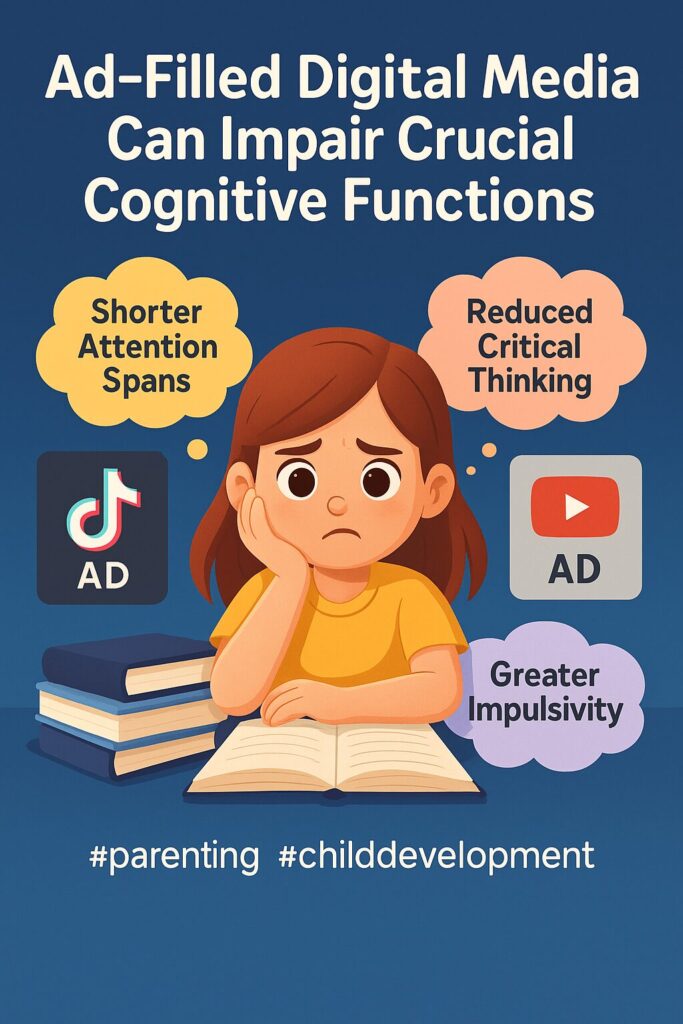
Lead by Example – Modeling Healthy Habits:
Children are keen observers and often model their behavior on that of their parents.
- Mindful Device Use: Put your own phone away during conversations with your children, during family meals, and at other important family times.29 This demonstrates respect and the importance of direct human connection.
- Critical Media Engagement: Let your children see you engaging critically with media and advertising. Comment on ads you see together, question their claims, and discuss their persuasive intent.54
Section 4.3: Nurturing Minds, Not Exploiting Them: The Importance of Positive Alternatives
Countering the negative influence of manipulative digital advertising is not just about restriction; it’s also about actively promoting positive and enriching digital experiences. The goal is to shift children’s engagement from passive, ad-driven consumption towards active, creative, and educational uses of technology.
The Need for Quality Content:
In a digital landscape saturated with manipulative advertising designed to hook and exploit developing minds 11, parents often search for safe, enriching alternatives that genuinely contribute to their child’s growth. The focus should be on content that encourages critical thinking, problem-solving, creativity, and emotional development, rather than simply maximizing screen time for ad revenue.
Introducing Lunesia – A Breath of Fresh Air:
Apps like Lunesia (https://lunesia.app) offer a stark and welcome contrast to the commercially driven platforms that dominate much of children’s screen time. Designed by experts specifically for children aged 3 and above, Lunesia provides a completely ad-free environment.
This is a critical distinction, as it removes the primary mechanism of manipulation discussed throughout this report. Within this safe space, children engage with interactive stories that are crafted not by algorithms focused on engagement metrics, but by child development experts.
These stories are designed to genuinely foster creativity, critical thinking, decision-making abilities, and emotional intelligence.
This focus on “meaningful screen time,” as Lunesia describes it, directly counters the passive consumption and commercial pressures prevalent on many other platforms.65 Unlike systems where algorithms push content to maximize eyeballs for advertisers 12, Lunesia’s curated, expert-created (and notably, not AI-generated) stories aim to teach important values such as love, kindness, sharing, and respect. They also help children conquer fears through positive, empowering narratives.65 By engaging with such content, children can develop the cognitive and emotional skills—like problem-solving and emotional regulation—that can, in turn, help them become more resilient to the persuasive tactics they inevitably encounter on other, less scrupulous platforms.
Lunesia, therefore, can be seen not just as a “safe alternative” but as a tool for “counter-programming,” actively building the cognitive defenses that commercial platforms often seek to bypass or undermine.
Beyond specific apps, parents should encourage a diverse range of activities that nurture holistic development. This includes ample time for outdoor play, reading physical books, engaging in creative hobbies, and fostering rich, face-to-face social interactions with family and peers.
Section 4.4: Spotting the Signs & Seeking Support
Despite best efforts, the pervasive nature of digital media means children may still experience negative impacts. Parents should be vigilant for warning signs and know when and where to seek help.
Warning Signs of Negative Impact 29:
- Noticeable increases in irritability, anxiety, or depressive moods, especially in relation to screen use.
- Persistent sleep disturbances or changes in sleep patterns.
- A decline in self-esteem, increased preoccupation with appearance, or negative body image talk.
- Difficulty concentrating, a drop in academic performance, or a lack of focus.
- Withdrawal from previously enjoyed activities, friends, or family.
- Becoming unusually upset, sad, or angry during or after using the internet or their phone.
- An unhealthy obsession with specific brands, online trends, or the need for particular virtual items.
- Unexplained financial charges that might be linked to in-app purchases.
When and Where to Get Help:
Parents should trust their instincts. If they are concerned about their child’s behavior, mood, or relationship with digital media, the first step is to talk openly with the child. Discussing concerns with teachers can also provide additional perspectives. If worries persist, consulting a pediatrician is a good starting point. They can offer guidance or refer to a child psychologist or other mental health professional specializing in children and adolescents. Reputable organizations like the American Academy of Child and Adolescent Psychiatry (AACAP) or the American Psychological Association (APA) often have resources on their websites for finding qualified professionals.
While parental strategies are crucial, the sheer scale and sophistication of the digital advertising ecosystem mean that individual efforts can sometimes feel like an uphill battle.8 The “counter-offensive” is therefore not just about restricting negative influences but also about actively cultivating critical thinking, emotional well-being, and a preference for quality, non-exploitative content. This transforms the challenge from a purely defensive posture to a proactive, positive endeavor to nurture resilient and discerning young minds.
Table 3: Your Parental Action Plan: Building Resilience Against Digital Manipulation
| Area of Action | Specific Strategy (What To Do) | Why It’s Effective (The Science) | Key Resources/Tools | Relevant Supporting Evidence |
| Open Communication & Media Literacy | Regularly discuss ads, their intent, and influencer marketing. Co-view and deconstruct media messages together. | Builds critical thinking, reduces ad susceptibility, helps children understand persuasive intent. | MediaSmarts.ca, CommonSenseMedia.org, Media Smart UK parent guides. | 52 |
| Setting Boundaries & Rules | Create and enforce a Family Media Use Plan. Establish tech-free zones (e.g., bedrooms at night) and times (e.g., meals). Delay social media access. | Reduces overall exposure to ads and manipulative content, improves sleep, focus, and family interaction. | AAP Family Media Plan Tool (healthychildren.org/MediaUsePlan). | 30 |
| Utilizing Tech Tools | Maximize privacy settings on devices and apps. Use reputable ad-blockers and tracking prevention tools. Explore platform-specific parental controls. | Minimizes data collection used for ad targeting, reduces direct ad exposure, gives more control over content. | Platform privacy guides (TikTok, YouTube, Instagram), ad-blocking software reviews. | 13 |
| Promoting Positive Alternatives | Encourage use of ad-free, educational, and creative apps. Prioritize outdoor play, hobbies, reading, and face-to-face interactions. | Fosters healthy cognitive and emotional development, offers safe and enriching screen time, reduces reliance on ad-driven platforms. | Lunesia.app (https://lunesia.app), local library programs, community sports/arts. | 29 |
| Monitoring & Seeking Help | Watch for behavioral changes (irritability, anxiety, withdrawal, academic decline). Trust your instincts. | Early intervention is key for mitigating long-term harm and addressing emerging mental health concerns. | Your Pediatrician, Child Psychologist, AACAP.org, APA.org. | 29 |
This action plan provides a framework. Consistency and adaptability are key, as the digital landscape and children’s developmental needs are constantly evolving.
Conclusion: Reclaim Your Child’s Future – The Time to Act is NOW
The evidence presented in this report paints an undeniable and deeply unsettling picture: the digital advertising ecosystem, particularly on platforms like TikTok, YouTube, and Instagram, is not a neutral space for children. It is an environment actively and scientifically engineered to capture their attention, exploit their developmental vulnerabilities, and manipulate their thoughts, feelings, and behaviors for commercial gain.3 The neurological, psychological, and behavioral consequences—from altered brain development and heightened anxiety to cultivated materialism and distorted realities—are not accidental side effects. They are, in many instances, the predictable outcomes of systems designed with profit, rather than child well-being, as the primary driver.
While the sophistication and pervasiveness of these manipulative tactics are indeed “sidérant”—staggering—parents are far from powerless. The strategies outlined in Chapter 4 offer a clear, evidence-based path forward. Open communication, the cultivation of media literacy, the establishment of firm boundaries, the strategic use of technology, and the promotion of positive alternatives can collectively build a powerful shield of resilience. Empowering children with the ability to critically evaluate the messages they encounter, and providing them with safe, enriching environments both online and offline, can make a significant difference in mitigating these harms. The consistent, informed action of a parent is the most immediate and impactful defense a child has.

However, the battle for our children’s minds cannot be won by individual parental efforts alone. The sheer scale of the data collection 8, the power of the algorithms 12, and the inadequacy of current regulatory frameworks 32 point to a systemic problem that demands systemic solutions. As researchers have noted, “Self-regulation isn’t working – stronger rules are needed”.48
Therefore, the call to action extends beyond the home:
- Implement the Strategies: Begin today. Use the knowledge and tools provided in this report to make immediate, positive changes in your child’s digital life.
- Share the Knowledge: This information is too critical to keep to oneself. Share this article—and the science it contains—with other parents, educators, healthcare providers, and community leaders. Collective awareness is the first step towards broader change.
- Advocate for Systemic Change: Support organizations and initiatives that are working to hold platforms accountable and push for stronger regulations that genuinely protect children from exploitative digital marketing practices. Our children’s developing minds should not be the testing ground for evermore sophisticated methods of commercial persuasion.
Each generation of children faces an increasingly complex and pervasive digital environment. If decisive action is not taken, what is currently alarming may become the accepted, and even more damaging, norm for future children.
This is not merely about protecting individual children from specific harms; it is about preserving the very essence of childhood—a crucial period for healthy development, free from relentless commercial exploitation and manipulation. The fight is for their minds, their emotional well-being, their future autonomy, and the kind of society we wish them to inherit. The time to act, with courage and conviction, is unequivocally NOW.
Sources des citations
- Stop Advertising to Kids: Campaing to Protect Children | NFEC, consulté le mai 14, 2025, https://www.financialeducatorscouncil.org/stop-advertising-to-kids/
- Children and Digital Marketing | UNICEF Child Rights and Business, consulté le mai 14, 2025, https://www.unicef.org/childrightsandbusiness/workstreams/responsible-technology/digital-marketing
- Advertising and Young People’s Critical Reasoning Abilities: Systematic Review and Meta-analysis – PMC – PubMed Central, consulté le mai 14, 2025, https://pmc.ncbi.nlm.nih.gov/articles/PMC9724173/
- Full article: Children’s vulnerability to advertising: an overview of four decades of research (1980s–2020s), consulté le mai 14, 2025, https://www.tandfonline.com/doi/full/10.1080/02650487.2022.2135349
- The Ethics of Marketing to Children: Should We or Shouldn’t We? – ENX2 Legal Marketing, consulté le mai 14, 2025, https://enx2marketing.com/should-companies-market-to-children/
- Behavioral Shifts: The Influence of Ads on Children – ENX2 Legal …, consulté le mai 14, 2025, https://enx2marketing.com/how-does-advertising-affect-childrens-behavior/
- Television Advertising Leads to Unhealthy Habits in Children; Says APA Task Force, consulté le mai 14, 2025, https://www.apa.org/news/press/releases/2004/02/children-ads
- Is advertising consuming childhood? – Adfree Cities, consulté le mai 14, 2025, https://adfreecities.org.uk/2024/10/is-advertising-consuming-childhood/
- www.ftc.gov, consulté le mai 14, 2025, https://www.ftc.gov/system/files/ftc_gov/pdf/p214505kidsadvertisingstaffperspective092023.pdf
- A scoping review of children’s and parents’ attitudes to and awareness of digital food marketing – PMC, consulté le mai 14, 2025, https://pmc.ncbi.nlm.nih.gov/articles/PMC11879646/
- Sweet-sounding adverts that leave a sour taste: – Unicef, consulté le mai 14, 2025, https://www.unicef.org/eap/media/9631/file/Social%20media%20marketing%20to%20children%20-%20Quilt%20Report.pdf
- Mastering TikTok’s Algorithm: Boost Your Ad Success with Effective …, consulté le mai 14, 2025, https://lseo.com/paid-media/paid-social-media-marketing/understanding-tiktoks-algorithm-for-better-ads/
- Social media algorithms explained | CBC Kids News – YouTube, consulté le mai 14, 2025, https://www.youtube.com/watch?v=F5tz887wXCY&pp=0gcJCfcAhR29_xXO
- The design tricks keeping your kids hooked on games and apps – University XP, consulté le mai 14, 2025, https://www.universityxp.com/news/2025/4/19/the-design-tricks-keeping-your-kids-hooked-on-games-and-apps
- Persuasive Digital Design: Appealing to Adults, Problematic for Kids?, consulté le mai 14, 2025, https://www.michiganmedicine.org/health-lab/persuasive-digital-design-appealing-adults-problematic-kids
- New Report from Common Sense Media Reveals Revolution in …, consulté le mai 14, 2025, https://www.prweb.com/releases/new_report_from_common_sense_media_reveals_revolution_in_advertising_to_kids_and_teens/prweb11532523.htm
- Fairplay Releases Report on Marketing to Children in Popular Video …, consulté le mai 14, 2025, https://www.childrenandscreens.org/newsroom/news/fairplay-releases-report-on-marketing-to-children-in-popular-video-gaming-platforms/
- fairplayforkids.org, consulté le mai 14, 2025, https://fairplayforkids.org/wp-content/uploads/2025/02/Buying-to-Belong.pdf
- CFPB Virtual Currency Comment Draft – Regulations.gov, consulté le mai 14, 2025, https://downloads.regulations.gov/CFPB-2025-0003-0103/attachment_1.pdf
- A Kids’ Privacy Adventure: Exploring the FTC’s Privacy and Lootbox case against Genshin Impact – ESRB, consulté le mai 14, 2025, https://www.esrb.org/privacy-certified-blog/a-kids-privacy-adventure-exploring-the-ftcs-privacy-and-lootbox-case-against-genshin-impact/
- www.wineme.uni-siegen.de, consulté le mai 14, 2025, https://www.wineme.uni-siegen.de/wp-content/uploads/2024/03/EnginTeymur_Thesis_1546923-Kopie_geschwaerzt.pdf
- Disclosing Influencer Marketing on YouTube to Children: The Moderating Role of Para-Social Relationship – PMC, consulté le mai 14, 2025, https://pmc.ncbi.nlm.nih.gov/articles/PMC6985591/
- Understanding the Influence of Advertising on Children – Kidslox, consulté le mai 14, 2025, https://kidslox.com/guide-to/advertising-to-children/
- rsisinternational.org, consulté le mai 14, 2025, https://rsisinternational.org/journals/ijriss/Digital-Library/volume-9-issue-2/3030-3035.pdf
- When mobile advertising is interesting: interaction of minors with ads and influencers’ sponsored content on social media – Re-Unir, consulté le mai 14, 2025, https://reunir.unir.net/bitstream/handle/123456789/14067/When%20mobile%20advertising%20is%20interesting.pdf?sequence=2&isAllowed=y
- Reports | Center For Digital Democracy, consulté le mai 14, 2025, https://democraticmedia.org/reports
- Research report: Manipulative digital marketing practices targeted at children and youth online, consulté le mai 14, 2025, https://euneighbourseast.eu/wp-content/uploads/2025/01/adwiseonline_research-report_manipulative-digital-marketing-practices-targeted-at-children-and-youth.pdf
- www.diva-portal.org, consulté le mai 14, 2025, https://www.diva-portal.org/smash/get/diva2:1664394/FULLTEXT01.pdf
- How Social Media Impacts Mental Health and Changes Brain Activity, and What to Do | Connecticut Children’s, consulté le mai 14, 2025, https://www.connecticutchildrens.org/growing-healthy/how-social-media-impacts-mental-health-and-changes-brain-activity-and-what-do
- Kids and Social Media – The Kids Mental Health Foundation, consulté le mai 14, 2025, https://www.kidsmentalhealthfoundation.org/mental-health-resources/technology-and-social-media/social-media-and-kids
- (PDF) Social Media Advertising Has a Negative Psychological Effect on Gen Z: It Needs Improvement – ResearchGate, consulté le mai 14, 2025, https://www.researchgate.net/publication/390979234_Social_Media_Advertising_Has_a_Negative_Psychological_Effect_on_Gen_Z_It_Needs_Improvement
- Children’s Online Privacy: Recent Actions by the States and the FTC – Mayer Brown, consulté le mai 14, 2025, https://www.mayerbrown.com/en/insights/publications/2025/02/protecting-the-next-generation-how-states-and-the-ftc-are-holding-businesses-accountable-for-childrens-online-privacy
- Everything You Need to Know About Marketing to Children Regulations, consulté le mai 14, 2025, https://enx2marketing.com/everything-you-need-to-know-about-marketing-to-children-regulations/
- Is It Illegal to Market to Kids? Key Laws You Must Know – ENX2 Marketing, consulté le mai 14, 2025, https://enx2marketing.com/marketing-to-children/
- FTC Report Reveals Extensive Surveillance by Social Media and Video Streaming Companies, Especially Affecting Children and Teens – Bitdefender, consulté le mai 14, 2025, https://www.bitdefender.com/en-gb/blog/hotforsecurity/ftc-report-reveals-extensive-surveillance-by-social-media-and-video-streaming-companies-especially-affecting-children-and-teens
- Media use and brain development during adolescence – PMC, consulté le mai 14, 2025, https://pmc.ncbi.nlm.nih.gov/articles/PMC5821838/
- Digital Media and the Developing Brain (Chapter 5) – Handbook of Adolescent Digital Media Use and Mental Health – Cambridge University Press, consulté le mai 14, 2025, https://www.cambridge.org/core/books/handbook-of-adolescent-digital-media-use-and-mental-health/digital-media-and-the-developing-brain/360247725A5A5523C4E5D5F9E968D784
- The Effects of Social Feedback Through the “Like” Feature on Brain Activity: A Systematic Review, consulté le mai 14, 2025, https://pmc.ncbi.nlm.nih.gov/articles/PMC11719588/
- Study shows habitual checking of social media may impact young …, consulté le mai 14, 2025, https://www.unc.edu/posts/2023/01/03/study-shows-habitual-checking-of-social-media-may-impact-young-adolescents-brain-development/
- Branding and a child’s brain: an fMRI study of neural responses to …, consulté le mai 14, 2025, https://pubmed.ncbi.nlm.nih.gov/22997054/
- The Developing Brain in the Digital Era: A Scoping Review of Structural and Functional Correlates of Screen Time in Adolescence – Frontiers, consulté le mai 14, 2025, https://www.frontiersin.org/journals/psychology/articles/10.3389/fpsyg.2021.671817/full
- The Impact of Social Media on Children’s Mental Health: A Systematic Scoping Review, consulté le mai 14, 2025, https://pmc.ncbi.nlm.nih.gov/articles/PMC11641642/
- Negative Effects of Social Media – Cleveland Clinic Health Essentials, consulté le mai 14, 2025, https://health.clevelandclinic.org/dangers-of-social-media-for-youth
- Children’s online marketing harms: roundtable reflections, consulté le mai 14, 2025, https://www.digital-futures-for-children.net/online-marketing-harms
- The ABCs of how online ads can impact children’s well-being – WeLiveSecurity, consulté le mai 14, 2025, https://www.welivesecurity.com/en/kids-online/abcs-online-ads-impact-childrens-well-being/
- Teaching Kids to Be Smart About Social Media (for Parents) | Nemours KidsHealth, consulté le mai 14, 2025, https://kidshealth.org/en/parents/social-media-smarts.html
- How digital media impacts child development – News & insight, consulté le mai 14, 2025, https://www.jbs.cam.ac.uk/2024/how-digital-media-impacts-child-development/
- Junk food ads flood children’s social media feeds, new study finds …, consulté le mai 14, 2025, https://www.phc.ox.ac.uk/news/junk-food-ads-flood-children2019s-social-media-feeds-new-study-finds
- Predatory Teen Marketing—Not Kid’s Stuff – New Jersey State Bar …, consulté le mai 14, 2025, https://njsbf.org/2025/03/20/predatory-teen-marketing-not-kids-stuff/
- Screen Dependency Disorders: a new challenge for child neurology – jicna, consulté le mai 14, 2025, http://jicna.org/index.php/journal/article/view/jicna-2017-119
- Lawsuit Against Social Media Companies | PDF – Scribd, consulté le mai 14, 2025, https://www.scribd.com/document/648284272/Lawsuit-against-social-media-companies
- www.researchgate.net, consulté le mai 14, 2025, https://www.researchgate.net/publication/387248957_THE_ROLE_OF_PARENTAL_MEDIATION_AND_EMOTIONAL_APPEALS_IN_CHILDREN’S_ADVERTISING_LITERACY#:~:text=Using%20a%20cross%2Dsectional%20survey,thinking%20and%20resistance%20to%20advertising.
- (PDF) THE ROLE OF PARENTAL MEDIATION AND EMOTIONAL …, consulté le mai 14, 2025, https://www.researchgate.net/publication/387248957_THE_ROLE_OF_PARENTAL_MEDIATION_AND_EMOTIONAL_APPEALS_IN_CHILDREN’S_ADVERTISING_LITERACY
- The Impact of Advertising on Children’s Self-Image – Double Care ABA, consulté le mai 14, 2025, https://doublecareaba.com/the-impact-of-advertising-on-childrens-self-image/
- An Evaluation of a Media Literacy Program Training Workshop for Late Elementary School Teachers – PMC – PubMed Central, consulté le mai 14, 2025, https://pmc.ncbi.nlm.nih.gov/articles/PMC3530162/
- Digital Media Literacy Framework – Grades 4-6 | MediaSmarts, consulté le mai 14, 2025, https://mediasmarts.ca/teacher-resources/digital-media-literacy-framework/digital-media-literacy-framework-grades-4-6
- Defining Digital Media Literacy | MediaSmarts, consulté le mai 14, 2025, https://mediasmarts.ca/digital-media-literacy/general-information/digital-media-literacy-fundamentals/defining-digital-media-literacy
- Media Literacy Archives – Media Smart, consulté le mai 14, 2025, https://mediasmart.uk.com/category/media-literacy/
- Parenting: How to Protect Your Child From Violence, Exploitation and Abuse | UNICEF USA, consulté le mai 14, 2025, https://www.unicefusa.org/what-unicef-does/parenting/protect-children-violence-exploitation-abuse
- Social media safety and kids: A parents’ guide – Kaspersky, consulté le mai 14, 2025, https://www.kaspersky.com/resource-center/preemptive-safety/parents-and-social-media
- Top 5 tips for parents on how to protect your kids online – CodaKid, consulté le mai 14, 2025, https://codakid.com/top-5-tips-for-parents-on-how-to-protect-your-kids-online/
- Children and Adolescents and Digital Media | Pediatrics – AAP Publications, consulté le mai 14, 2025, https://publications.aap.org/pediatrics/article/138/5/e20162593/60349/Children-and-Adolescents-and-Digital-Media
- Behind the algorithm: Social media and your child – YouTube, consulté le mai 14, 2025, https://www.youtube.com/watch?v=GaYPOz6tTbc
- Advertising on YouTube Kids – Google Help, consulté le mai 14, 2025, https://support.google.com/youtube/answer/6168681?hl=en
- Lunesia – Interactive Bedtime Stories & Educational App for Kids, consulté le mai 14, 2025, https://lunesia.app
